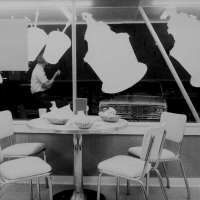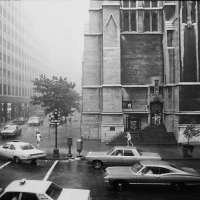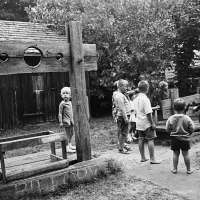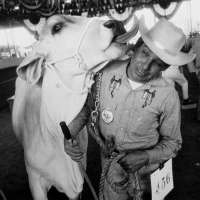

Garry Winogrand
New York City (man's hand, monkey in window, children) Garry Winogrand Portfolio, Hyperion Press, 1978, c. 1964
Garry Winogrand
Garry Winogrand Biography Garry Winogrand, called “the central photographer of his generation” in 1978 by John Szarkowski, is considered one of the most influential photographers of the second half of the twentieth century. Born in New York, where he lived and worked for much of his life, Winogrand studied painting at City College and Columbia University. He then went on to study photography at The New School with Alexey Brodovich, the art director at Harper’s Bazaar. He got his start in commercial photography but soon found his photographic passion was in making his own pictures on the streets of New York and across America. Often referred to as a street photographer, his pictures broke open new possibilities for how a “documentary” photograph might be defined. Throughout the 1960s and 70s, he captured the visual cacophony of city streets, people, rodeos, airports, and animals in zoos creating visual commentaries on modern life. In Winogrand’s unique approach to the act of photographing he put himself in the middle of the scene actively participating in the performance being played out by his, mostly unaware, subjects. H didn’t study framing through the lens and instead composed instantaneously, impulsively, improvisationally, as if he were making a kind of pictorial jazz piece. Working in a crowd, he brought the Leica to his eye—and dropped it away from his eye—so rapidly that, as the photographer, Tod Papageorge said, “people didn’t know whether they were being photographed or not, whether he even took the picture.” There is a seemingly choreographed dance happening in many of his pictures. One of the most famous examples of this performance caught on film is his image titled World’s Fair, New York City, New York, 1964. Winogrand felt that pictures described a piece of time and space within the four corners of the frame but not what was happening. In his words, “A photograph is not what is photographed, it is something else.” He was the recipient of numerous grants including a National Endowment for the Arts Fellowship and several Guggenheim Fellowships to produce 'photographic studies of American life,' to study 'the effect of the media on events,' and to “photograph California.” He taught photography at the School of Visual Arts and Cooper Union in New York, and the Art Institute of Chicago, among other institutions; and published seven books of photographs, including The Animals (1969), Women Are Beautiful (1975), and Public Relations (1977). Winogrand's photographs were exhibited widely during his lifetime, including Edward Steichen's The Family of Man at the Museum of Modern Art, Towards a Social Landscape at the George Eastman House, and the 1967 New Documents exhibition, curated by John Szarkowski at the Museum of Modern Art. In 2013 the San Francisco Museum of Modern Art mounted a major retrospective exhibition including over 160 of Winogrand’s photographs. The exhibition traveled to venues including the National Gallery of Art in Washington D.C.; The Metropolitan Museum of Art, New York; Jeu de Paume, Paris, France; Fundacíon MAPFRE, Madrid, Spain. His photographs are included in the collections of the Museum of Modern Art, New York, the Metropolitan Museum of Art, the National Gallery of Art, the San Francisco Museum of Modern Art, among others When he died suddenly at age 56, Winogrand left behind more than 10,000 rolls of film – more than a quarter of a million pictures and a quarter of his life’s works. These images capture a bygone era, the New York Mad Men, the early years of the Women’s Movement, the birth of American suburbs, and the glamour and alienation of Hollywood.







